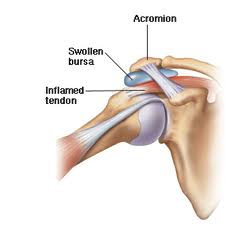Having had a number of patients visit my osteopathic clinic in recent months with shoulder impingement, I thought that this had be my next blog. The patients who presented with signs of impingement were mostly in their 40s and many were triathletes & or swimmers.
What is Shoulder Impingement?
Neer in 1972 introduced the term rotator cuff impingement, this is when one or more of the rotator cuff muscle tendons becomes impinged between the head of the humerus (ball of arm) and the acromial process of the scapular (shoulder blade). This area is known as the subacromial space.
There are 4 muscles that make up the rotator cuff, supraspinatus, subscalularis, teres minor and infraspinatus. These muscles are responsible for stabilising the shoulder joint and allowing free movement for a very mobile joint. Any of these tendons, most commonly supraspinatus due to position, may become inflammed thus reducing the subacromial space and in turn may irritate the subacromial bursa (sac of fluid), leading to bursitis and more swelling and pain in raising the arm.
Swimmers Shoulder
Shoulder impingement is often know as ‘swimmers shoulder’. Swimmers are at risk of rotator cuff injury due to a number of reasons. Firstly the hours of training will inevidently lead to muscular fatigue and over-use, secondly their shoulder flexibility is way beyond the norms which can lead to laxity.
In swimming the rotator cuff muscles provide stabilisation so that the power muscles can pull the arm through the water with the hands acting as paddles. This increase in flexibility can mean laxity and reduced stabilisation putting more stress on shoulder ligaments and rotator cuff tendons (which act as ligaments). The solution is to make sure that your deep intrinsic rotator cuff muscles are strong as well as your power muscles ie deltoids, latissmus dorsi & pecs.
How to treat
Unless impingement is caught early in its acute phase it can be tricky to treat. Obviously a good initial diagnosis is imperavtive with an understanding of why this has occured so that changes to technique, posture, training load etc may be made.
Congenital differences in the shape of the acromion can predispose to impingement, for example those with a type 111 shape (hooked) can reduce the sub-acromial space (Bigliani et al 1986).
Poor posture can lead to muscle imbalance and alter the biomechanics of the shoulder, predisposing to rotator cuff imbalance. Age is the other factor, degenerative changes, bony spurs and fibrotic tendons will also have an effect on reducing subacromial space. This is when surgery is likely to be the only successful outcome.
Osteopathic treatment
An osteopath will look at the contributing and maintaining factors, addressing these and also aim to reduce any local inflammation. Swimming technique may be the contributing factor whereas poor posture at work may be the maintaining and reason why the injury is not healing sufficiently.
I personally have found that kinesio taping is very effective in helping to treat an acute and sub-acute shoulder impingement. Kinesio tape can be used to increase the sub-acromial space whilst taking tension out of the surrounding muscles.
I hope this was informative and helpful and please feedback any comments or questions you have.
contact Lisa on 07956 954093 or email lisa@osteopath-west for appointments.









